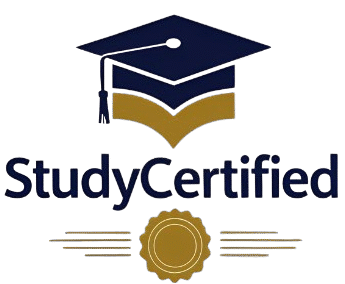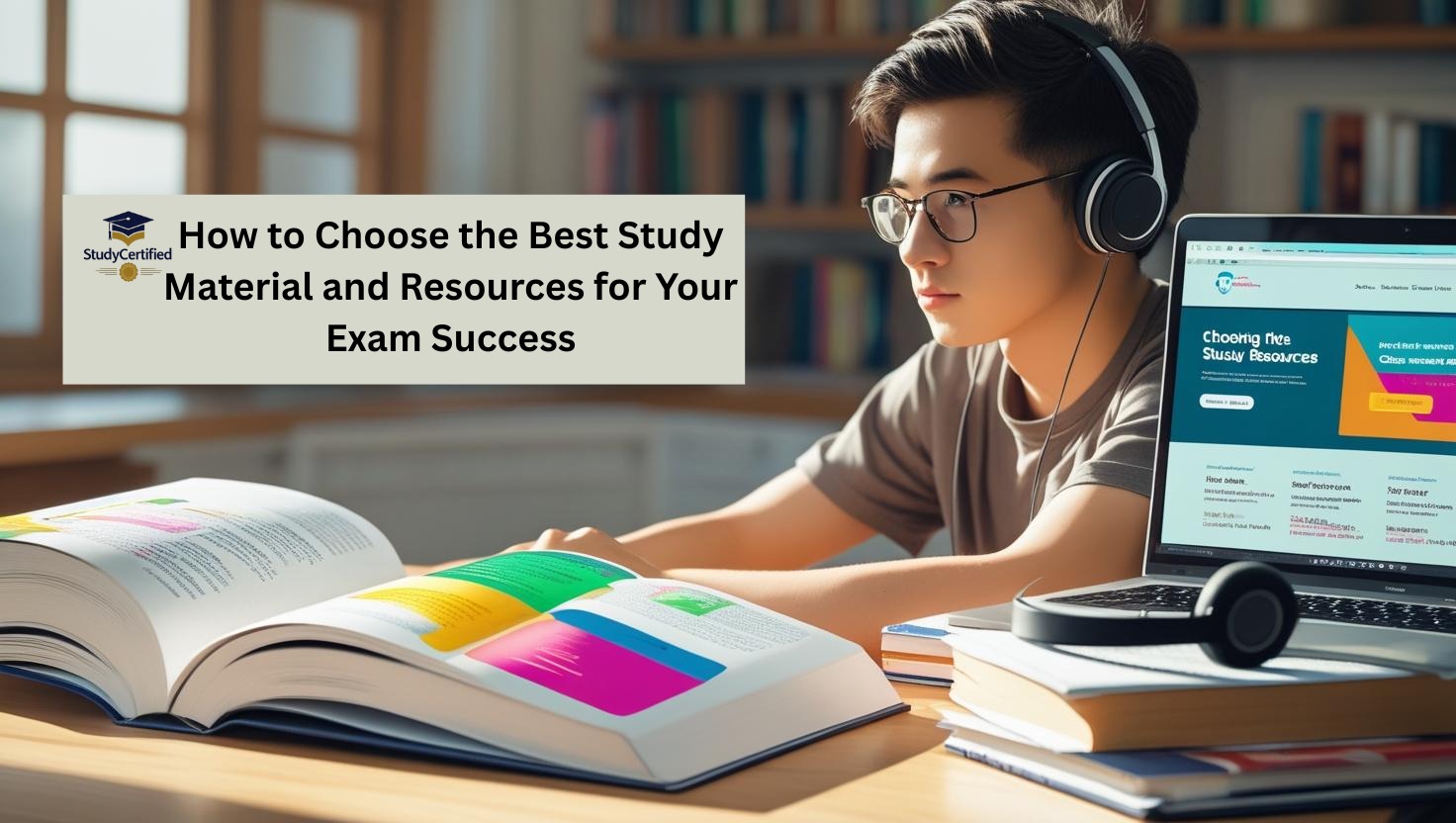When you decide to prepare for any professional certification, academic test, or entrance exam, the most important decision you’ll make is this:
How do you choose the right study material and resources for your exam? Whether you’re preparing for the SAT, GRE, PMP, CPA, or any competitive exam, choosing the right study materials is crucial. The internet is overflowing with prep guides, courses, videos, and apps, but not all resources are created equal.
Some are outdated. Others don’t align with your exam. And many fail to match your learning style.
So, how do you avoid wasting time and money and pick the right tools that actually help you pass?
Now, the question is “How to select the most effective study resources customized to your specific exam, learning preferences, and career goals—whether you’re a student, job seeker, or professional.”
Understand the Structure and Format of Your Exam Before You Start Studying
Start with the Official Exam Syllabus
The first step in effective exam preparation is reviewing the official syllabus provided by the exam body—whether it’s ETS, PMI, CompTIA, the College Board, or any other recognized authority.
This syllabus outlines the core topics, learning objectives, and competencies that will be tested.
Avoid studying blindly. Choose materials that directly align with the official curriculum to ensure you’re focusing on what actually matters.
Learn the Exam Format and Question Types
Understanding how the exam is structured is just as crucial as knowing what content to study. Does the test include multiple-choice questions, essay responses, case studies, or performance-based simulations?
Some exams, like the GMAT, use adaptive scoring, where the difficulty adjusts based on your performance in real-time.
By choosing mock exams and study tools that simulate the actual format, you’ll improve both accuracy and confidence. Practicing under real exam conditions can significantly enhance your performance.
Don’t Overlook Timing and Scoring Patterns
In addition to the format, it’s important to know the timing of each section and how the scoring works. Are some sections weighted more heavily than others? Are there penalties for wrong answers?
Understanding these details helps you create an effective study plan, manage your time wisely during the exam, and avoid last-minute surprises.
Also, check the exam retake policy and test frequency—especially if you’re taking a standardized or professional certification test. Knowing these logistics can ease anxiety and improve planning.
Identify Your Learning Style to Choose the Most Effective Study Resources
Maximizing exam success starts with understanding how you learn best. Tailoring your study materials to your unique learning style boosts retention, speeds up preparation, and reduces frustration.
Here’s a breakdown of common learning styles and the best resources for each:
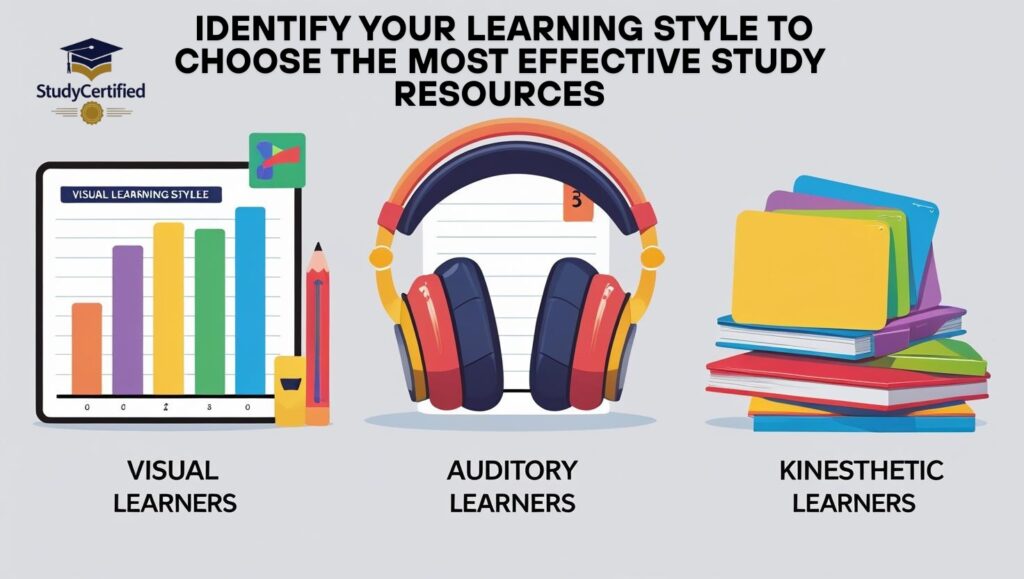
Visual Learners: Learn Better by Seeing
Visual learners absorb information best through images, videos, charts, and diagrams. If this sounds like you, prioritize video tutorials, illustrated guides, and infographics to simplify complex topics.
Top resources for visual learners:
- YouTube educational channels such as Khan Academy and CrashCourse
- Online platforms offering rich visual content like Coursera and edX
- Infographic-based study guides to reinforce key concepts
Auditory Learners: Learn Better by Listening
If you grasp information more effectively through listening, utilize podcasts, audio lectures, and audiobooks. These allow you to study flexibly—during commutes, workouts, or breaks.
Top resources for auditory learners:
- Audible exam prep audiobooks
- Exam-focused podcasts like GRE Snacks
- Mometrix audio lessons and recorded lectures
- YouTube channels with clear verbal explanations
Kinesthetic Learners: Learn Better by Doing
Kinesthetic learners thrive with hands-on interaction. Engage with flashcards, practice quizzes, interactive simulations, and real-world application exercises to enhance comprehension.
Top resources for kinesthetic learners:
- Anki and Quizlet for active flashcard learning
- UWorld and Kaplan for realistic test simulations
- Interactive quizzes and practice exams that mimic test conditions
Why Matching Study Materials to Your Learning Style Matters
Choosing study tools that fit your learning preferences improves information retention, increases study efficiency, and enhances exam performance. Instead of struggling with generic resources, you can focus your energy on methods proven to work for you.
Use Reputable, Updated Study Resources for Exam Success
Choosing the right study platforms is crucial for effective exam preparation. To maximize your chances of passing, rely on trusted, up-to-date resources that are widely recognized and relevant to exams in the USA.
Top-Rated and Trusted Study Platforms in the USA
- Magoosh: Ideal for GRE, SAT, TOEFL, and GMAT prep, Magoosh offers comprehensive video lessons, practice questions, and personalized study plans trusted by thousands of test takers.
- UWorld: The go-to platform for CPA, NCLEX, and various medical certification exams, UWorld provides high-quality practice questions and detailed explanations to build mastery.
- LinkedIn Learning: Perfect for professionals preparing for PMP and other business certifications, LinkedIn Learning delivers expert-led courses that combine theory with practical skills.
- Coursera & edX: These platforms offer university-level courses and specializations from top institutions, ideal for deep conceptual understanding and certification preparation.
- Khan Academy: A free, reliable resource, especially effective for building foundational concepts in subjects tested on exams like the SAT.
Common Study Resource Mistakes to Avoid
- Using outdated PDFs or study guides that no longer reflect current exam content or format
- Relying on pirated, fake, or unverified prep material,s which may provide inaccurate information and harm your chances
- Selecting study resources that don’t align with your specific exam’s format and syllabus, leading to wasted time and ineffective preparation
Why Choosing Updated, Relevant Study Materials Matters
Using reliable and updated study resources not only keeps you aligned with current exam standards but also ensures you develop the skills and knowledge tested on exam day. Avoiding outdated or irrelevant materials saves you time, money, and frustration, helping you stay confident and well-prepared.
Free vs. Paid Study Resources: Which One Is Right for Your Exam Prep?
Choosing between free and paid study materials is a common dilemma for many exam candidates. Both options have their strengths and drawbacks, and understanding these can help you create a balanced, effective study plan.
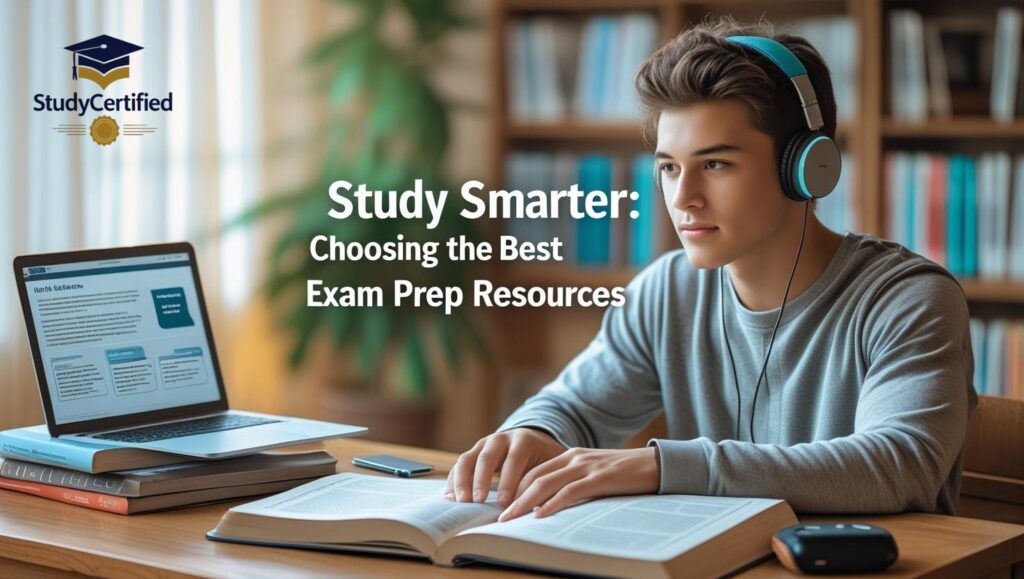
Free Study Resources: Accessible and Beginner-Friendly
Popular free tools include:
- YouTube channels like CrashCourse and Mometrix that offer video lessons covering core concepts
- Reddit communities such as r/SAT, r/GRE, and r/CPAExam, where candidates share tips, study plans, and resources
- Quora, educational blogs, and open courseware from institutions like MIT and Harvard provide valuable insights and foundational knowledge
Pros:
- Completely free and easy to access anytime, anywhere
- Ideal for beginners who want to build a solid understanding without financial commitment
Cons:
- Often lack depth and detailed explanations
- No personalized study plans or progress tracking
- May not always be aligned perfectly with the latest exam formats
Paid Study Resources: Comprehensive, Structured, and Exam-Focused
Top paid platforms include:
- Kaplan, Magoosh, UWorld, and Princeton Review—trusted for delivering full-length practice tests, expert feedback, and progress tracking features
Pros:
- Structured courses designed to mirror real exam conditions and formats
- Access to detailed explanations, personalized coaching, and adaptive learning paths
- Higher success rates among serious candidates who invest in their preparation
Cons:
- Can be costly, but often worth the investment for targeted and effective exam readiness
Expert Tip: Combine Free and Paid Resources for Optimal Results
Start with free materials to grasp the basics and identify your weak areas. Then, invest in paid tools for intensive practice, personalized feedback, and exam simulations. This hybrid approach maximizes learning efficiency while managing costs.
“How to Prioritize Practice Tests and Performance Tracking for Exam Success”
When it comes to effective exam preparation, practice tests are essential. They help you familiarize yourself with the real exam environment, reduce anxiety, and improve your time management and accuracy.
Best Practice Test Platforms for USA Exam Takers
- UWorld — Renowned for high-quality, detailed questions, especially for medical exams, CPA, and other professional certifications. Its explanations and adaptive learning features help build deep understanding.
- Magoosh — Offers clear answer explanations and robust test analytics to track your progress and identify areas for improvement.
- PrepScholar — Known for customized learning paths tailored to your strengths and weaknesses, boosting study efficiency.
- TestPrepPractice.net — Provides a large free test bank with realistic practice questions across multiple subjects.
- Kaplan Test Prep — Offers premium, full-length practice exams that mirror the real test’s format and difficulty.
Track Your Progress Regularly
Consistently monitor your practice test scores on a weekly basis. Use this data to:
- Pinpoint your weakest topics
- Adjust your study plan accordingly
- Focus your time on areas needing improvement
- Build confidence by measuring steady progress
Why Practice Tests and Tracking Matter
Regular practice under exam-like conditions improves familiarity with the test format and pacing, reducing surprises on test day. Performance tracking helps ensure your preparation stays on track and maximizes your study efficiency.
Real PMP Success Story: How Maria Aced the Exam with the Right Tools
Maria, a motivated project manager based in New York City, began her PMP exam preparation using free YouTube tutorials and various online resources. While these initial materials helped her grasp fundamental project management concepts, she quickly encountered difficulties tackling situational decision-making questions and mastering the complex simulation-based problems frequently tested on the PMP exam.
Understanding that a more focused and structured study approach was necessary, Maria switched to LinkedIn Learning’s PMP courses for expert-led video lectures. She also invested in the latest PMBOK Guide, ensuring her preparation aligned precisely with the official PMP exam syllabus. To boost her test-taking skills and exam readiness, Maria utilized UWorld’s PMP practice tests, which offer realistic simulations and in-depth explanations.
Within just six weeks, Maria elevated her mock exam scores from 62% to an impressive 87%, significantly enhancing her confidence and mastery of critical PMP concepts. Ultimately, she passed the PMP exam on her very first attempt.
Why Maria’s Success Story Matters for PMP Candidates
Maria’s journey is a powerful example of how targeted, up-to-date study materials combined with focused practice tests can overcome common PMP exam challenges. Her success underscores the importance of:
- Using trusted PMP prep courses like LinkedIn Learning
- Studying with the latest PMBOK Guide aligned to current exam standards
- Consistent practice with high-quality mock exams from platforms like UWorld
- Tailoring your study plan to focus on weak areas identified through performance tracking
Infographic-Style Summary: Choose the Right Study Resources in 5 Simple Steps
Finding the right study materials can be overwhelming, but it doesn’t have to be. Whether you’re preparing for a certification exam, a college test, or a professional assessment, selecting resources that match your learning style and goals is key. This quick 5-step guide will help you choose the most effective study tools to boost your confidence, save time, and get real results.
1. Understand Your Exam
- Review the official syllabus thoroughly
- Familiarize yourself with question formats (MCQs, essays, simulations)
2 Identify Your Learning Style
- Visual learners: Use videos, charts, and infographics
- Auditory learners: Rely on podcasts and audiobooks
- Kinesthetic learners: Focus on practice tests and flashcards
3 Use Trusted and Proven Resources
- Top platforms include Magoosh, UWorld, Kaplan, and Khan Academy
4 Combine Free and Paid Materials
- Use free resources to build foundational concepts
- Invest in paid courses and test banks for structured learning and realistic practice
5 Practice Regularly and Track Your Progress
- Take full-length mock exams weekly
- Analyze your mistakes carefully
- Continuously adjust your study plan to improve weak areas
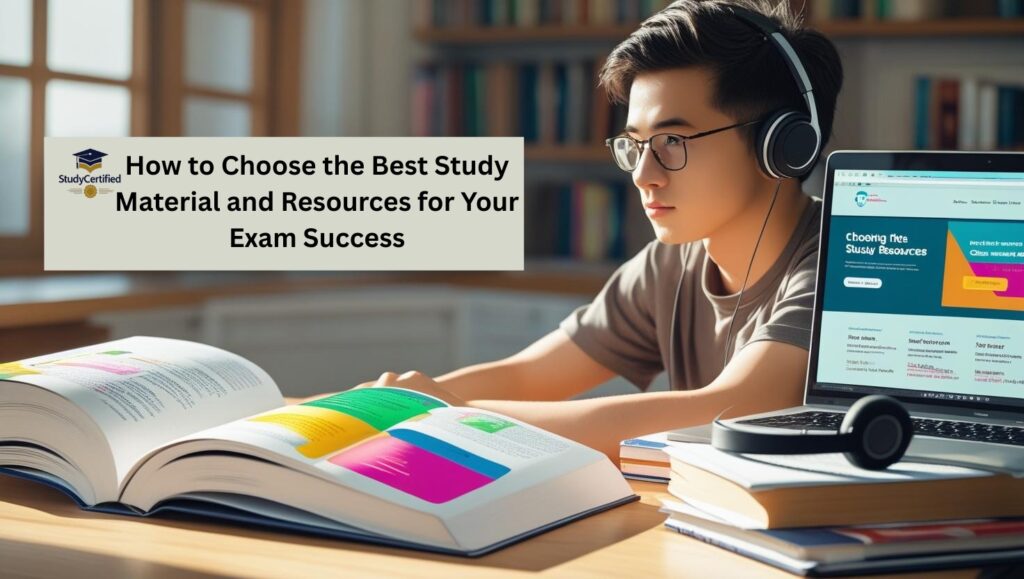
Frequently Asked Questions (FAQs)
Q1: What is the best study material for competitive exams like SAT or GRE in the USA?
A: Use a mix of updated official guides, Magoosh, Khan Academy, and mock test providers like UWorld or Kaplan. Always align with the latest syllabus.
Q2: Are paid exam prep courses really worth the investment?
A: Yes, especially for high-stakes exams. Paid resources provide structure, expert guidance, and mock tests which are often missing in free content.
Q3: Can I pass a certification like the CPA or PMP using only free resources?
A: It’s possible, but not recommended. Free tools can help with concepts, but passing requires exam-aligned material and structured practice—usually found in paid resources.
Q4: How do I verify if a study resource is outdated?
A: Check the publishing year and compare it with the official exam’s current version. Avoid anything older than 2 years unless confirmed as still relevant.
Q5: What’s the most common mistake students make when choosing study materials?
A: Choosing random or pirated content, ignoring learning styles, skipping practice tests, and falling for “guaranteed pass” scams.
Q6: What is the best way to study materials?
A: Use resources aligned with the official syllabus, match them to your learning style, and combine video lessons, practice tests, and tracking tools for consistent progress.
Q7: What kinds of resources can you use during the exam?
A: Most exams in the USA are closed-book. However, some certifications (like open-book exams) may allow specific guides or calculators—always check the official exam policy.
Q8: Which is the hardest exam in the USA?
A: Exams like the USMLE (for medical licensure), California Bar Exam, and CFA (Chartered Financial Analyst) are considered among the toughest due to their depth and pass rates.
Final Thoughts: How to Choose the Best Study Materials & Resources for Exams
When it comes to exam success, especially in the competitive landscape of the USA, your study resources matter more than you think. The right tools can save you time, reduce stress, and boost your scores, while the wrong ones can leave you frustrated and stuck.
That’s why this blog, “How to Choose the Best Study Materials and Resources for Exams,” breaks down everything you need to build a smarter, more personalized prep plan. To wrap it up, here are the key takeaways:
- Start with the official syllabus of your exam (SAT, GRE, PMP, etc.)
- Choose resources that fit your learning style—visual, auditory, or hands-on
- Use a mix of free and paid tools to cover both concepts and practice
- Make practice tests a weekly habit to build confidence
- Track your performance and fine-tune your study plan regularly
Stay away from outdated content, shortcuts, or sketchy PDFs

I am an Assistant Professor at UCSC with a background as a Postdoctoral Scholar in Environmental Policy, Science, and Management at UC Berkeley. My research centers on soil biophysiochemical processes and nitrogen cycling, aimed at mitigating agriculture’s environmental footprint. I hold a PhD and MS in Soils and Biogeochemistry from UC Davis, where I received the DOE Office of Science Graduate Student Research award. My work combines field investigations, laboratory experiments, and modeling. Additionally, I have provided international consulting on soil remediation. I earned a BA in Mathematics from Bryn Mawr College and previously contributed to the University of Delaware’s Environmental Soil Management Group.
